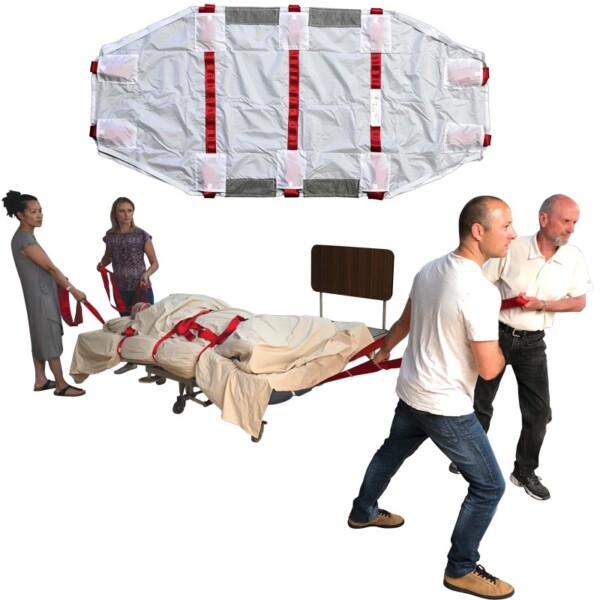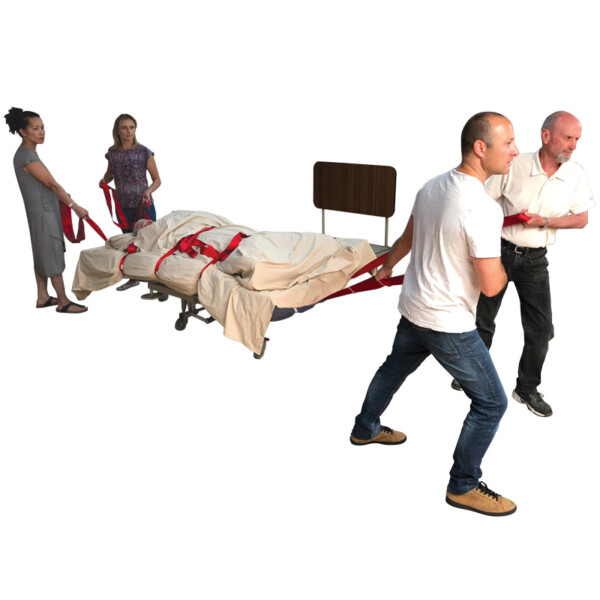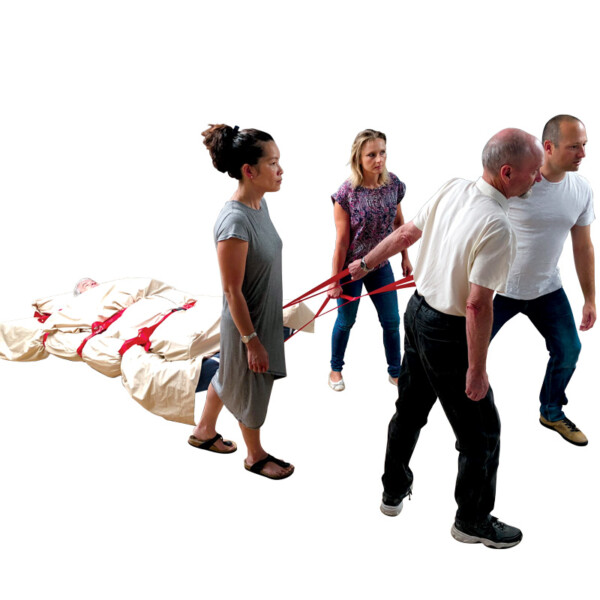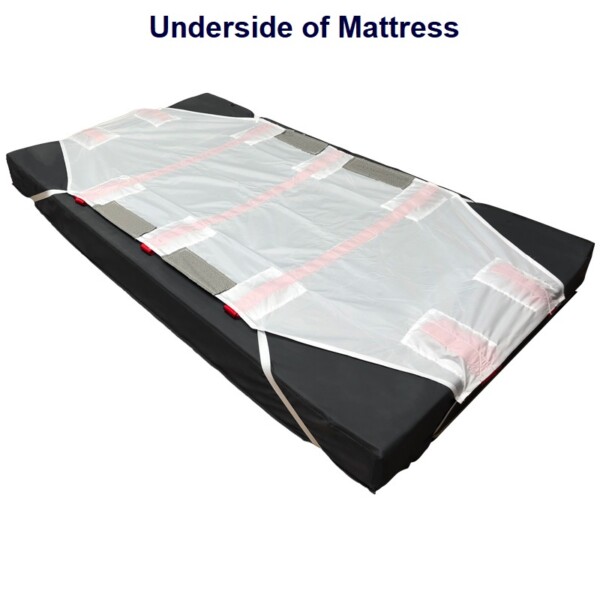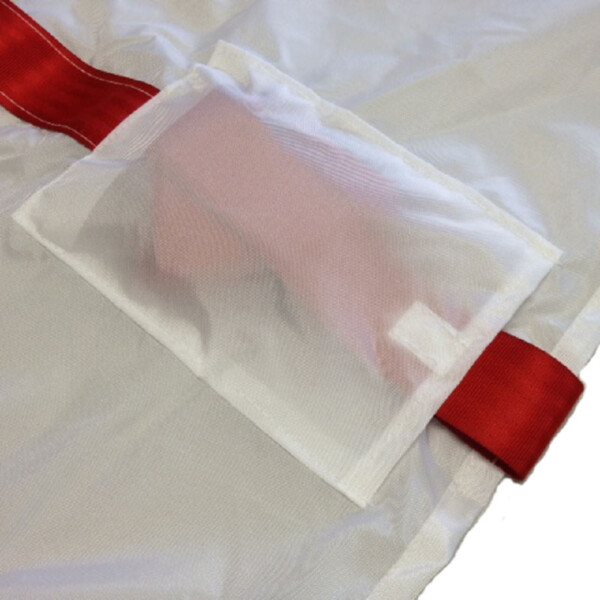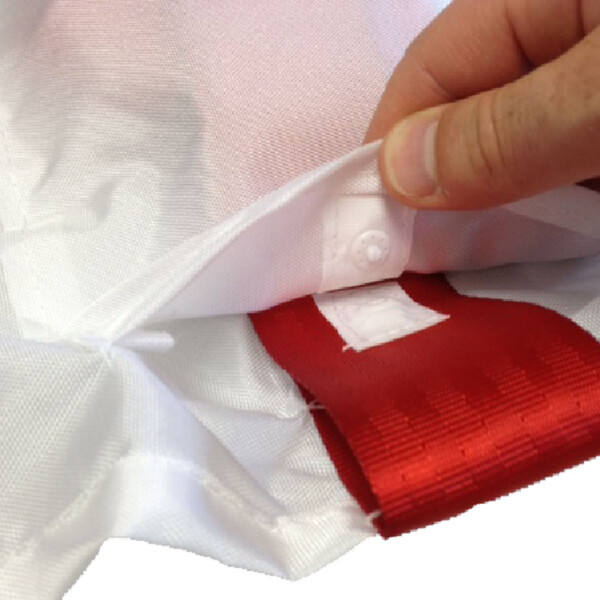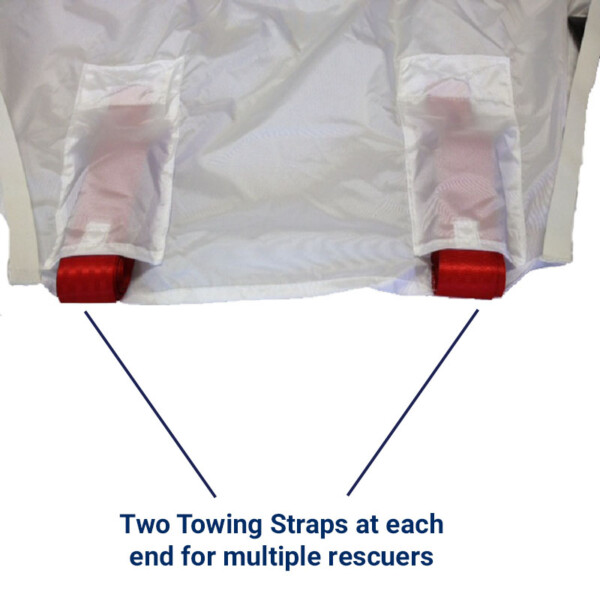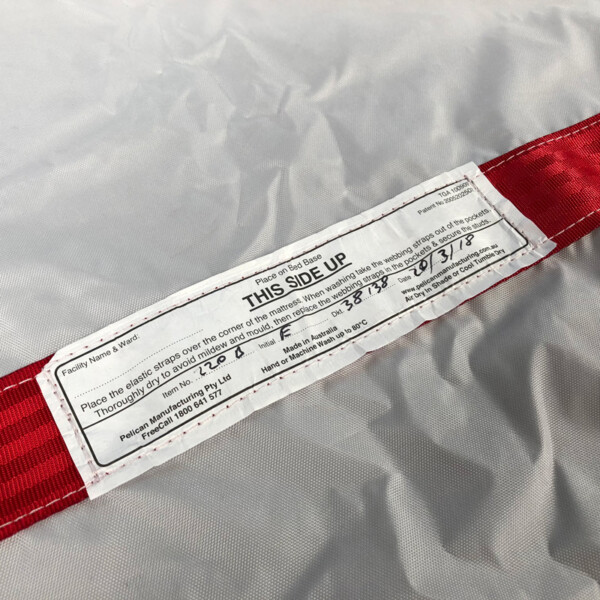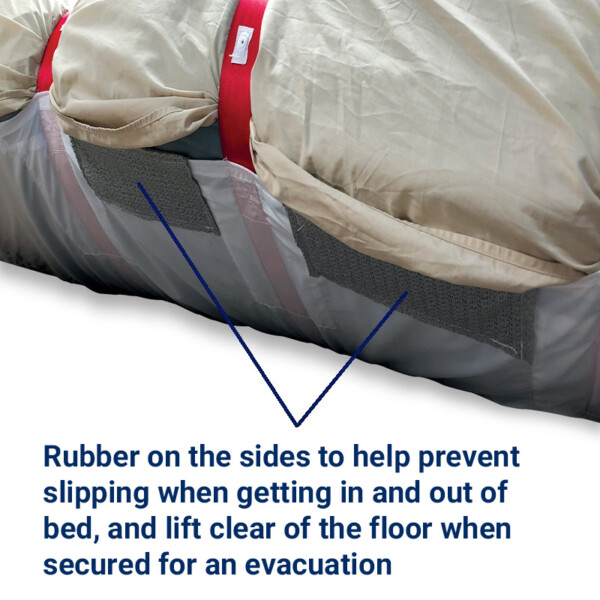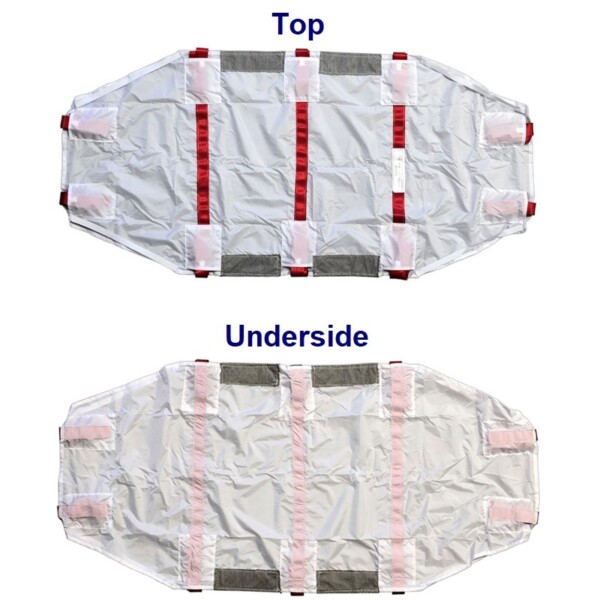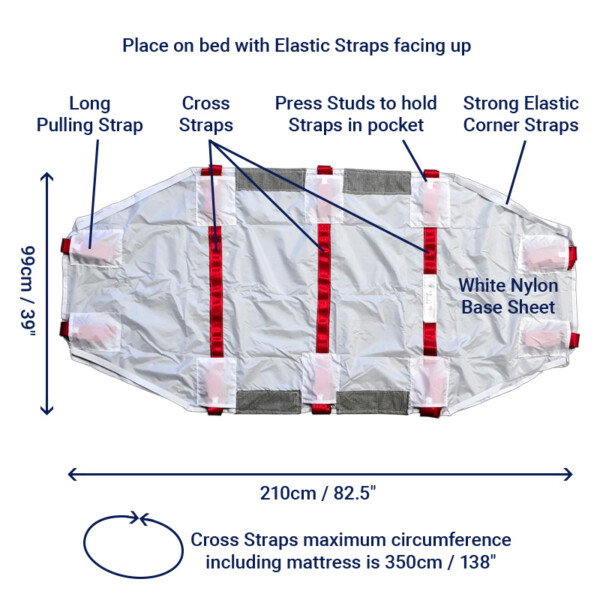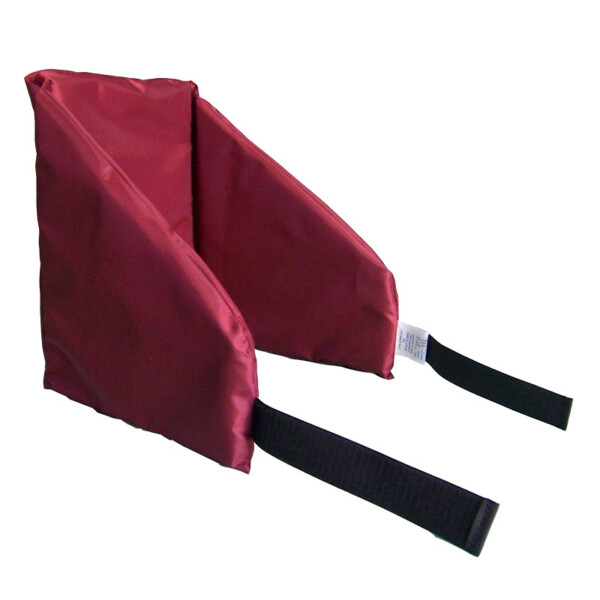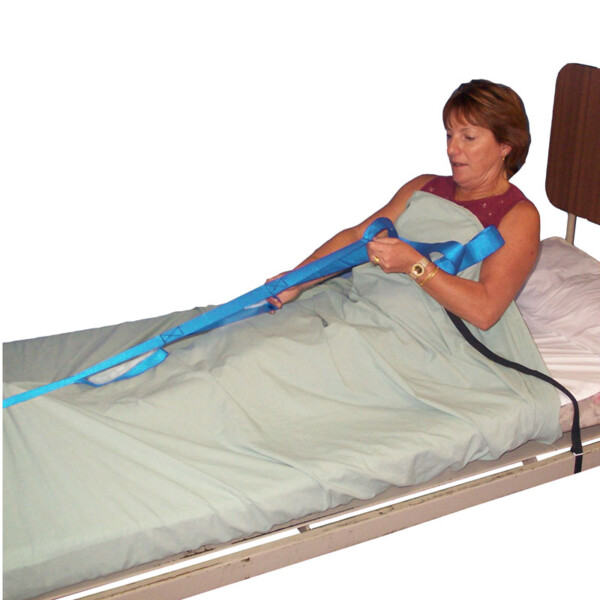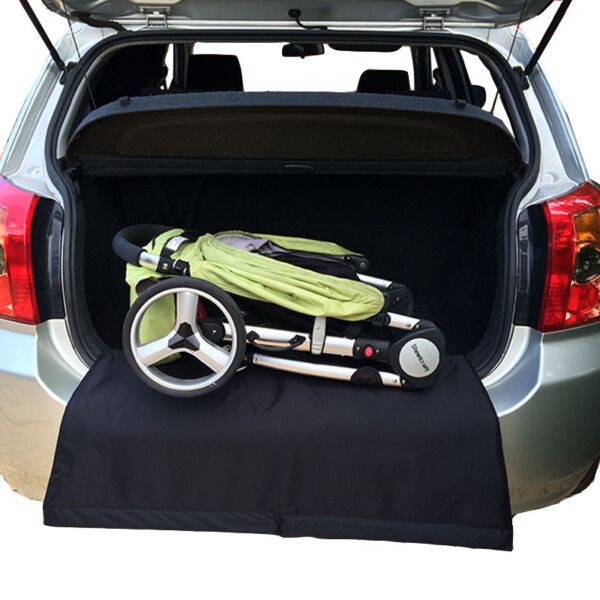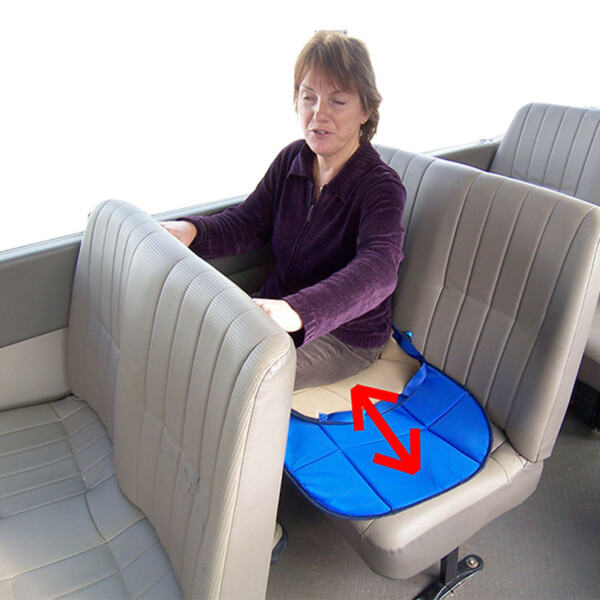Description
Main Features
- For emergency evacuation of non-ambulant patients
- 2 long pulling straps at each end, sewn with extra loops down the length to allow for more rescuers
- Press studs & pockets for the Cross Straps to help contain the straps and prevent them getting caught in side rails
- Plastic buckles – safer than metal buckles when detached under strain, and will not damage a washing machine
- 3 Cross Straps sewn all the way across the material for extra strength – especially good for sliding on rough tarmac/bitumen/concrete
The ResQsheet- Bariatric Size is kept in position under the mattress with strong elastic corner straps. Daily bed making is as normal. If there is an emergency, then the webbing straps are removed from their pockets and quickly done up around the mattress and the patient. The head and foot end pulling straps are also taken out from under the mattress. The mattress and the patient are then lowered onto the floor for very fast and safe evacuation. The patient is protected by their mattress and they can be easily taken down stairs to safety.
After evacuation, the patient can be left still cocooned in the ResQsheet which may be helpful with patients who are liable to wander. The Cross Straps are sewn across the full width of the ResQsheet to provide extra security in case the strong nylon material should tear on a rough surface, i.e. driveways, roads, etc.
Special Features
Special Press Studs (Patent Applied For) are on the Pulling Straps and the Cross Straps. By doing the Press Studs up, the webbing will be kept in place to help prevent the Pulling Straps falling off the ends of the bed. There have been occasions when these straps have been tangled on attachments to the bed and have delayed a fast evacuation. The Cross Straps also have Press Studs to stop the straps falling between the bed side rail and the bed base.
Two pieces of Miracle Grip Rubber material are sewn to each side, at the top and bottom. A trend with hospital beds is to no longer have small metal bars to hold a mattress in position. This means that the mattress may slip when someone gets into or out of bed. If you find that using this product may contribute to the mattress sliding on the bed frame, we suggest using our Anti Slide Mattress Sticks or Anti Slide Mattress Pad.
There are many names by which this type of item is known. Some include: Evacuation Sheets, Fire Sheets, Fire Rescue Sheets, Fire Evacuation Sheets, Fire Blankets, or Ski Sheets.
COMPARISON BETWEEN OUR RESQ PRODUCTS
Click here to view the Features List for the range of Pelican evacuation devices.
To Install
The ResQsheet is positioned under the mattress so that the ‘This Side Up’ label is on top. Place the four elastic straps over each corner of the mattress to help keep the ResQsheet in position when bed making. The Cross Straps should be folded into the pockets provided, with the Press Studs fastened ready for easy access in an emergency. The Pulling Straps should be secured in place with the Press Studs.
To Use
Pull the Cross Straps out of the pockets and join the buckle with the strap from the opposite pocket over the patient and bed clothes. A pillow may be placed on the patient’s chest and another across the legs, under the Cross Straps to further protect the patient.
Pull the Cross Straps tight to cocoon the patient, complete with sheets and blankets still inside the mattress. Take out the Head and Foot Pulling Straps from under the mattress. Lower the bed as far as possible. Then use the Straps to lower the patient and mattress off the bed and slide along the floor by using the long Pulling Straps at either end. ResQSheet Extension Straps are available which can fit to any of the Pelican ResQ products to allow for more people to pull.
The ResQsheet – Bariatric, is made from a strong white nylon material which is easy to see in the dark when taken outside if an evacuation takes place at night.
Testing
The materials used to make the ResQsheets are the same as we use for our Lifting Slings. When doing NATA Testing, the Slings lifted 1,000kg / 2200lbs without failing.
When carrying out ‘In House’ testing, the ResQsheets were pulled at a fast walking speed on carpet and concrete. Loads of 203kg / 447lbs, and 302kg / 665lbs were tested. The test results can vary on different grades of carpet depending on the pile and underlay. Therefore these results are just an indication of the reduction. The Initial Force was when the ResQsheets were on the floor. After taking the mattress off the bed, and starting to slide straight away, the initial force should be less.
| Number of people pulling | Weight pulled | Initial load for each person pulling on Carpet | Initial load each person pulling on painted Concrete |
| Four | 203kg / 447lbs | 24.5kg / 54lbs each | 19kg / 41.8lbs each |
| Four | 302kg / 665lbs | 28.5kg / 62.8lbs each | 21.5kg / 47lbs each |
Plan Escape Routes for Fire Evacuation
Do not have furniture that may impede pulling the mattress and patient down a corridor. Make sure that there is enough space to leave the room and to turn in the corridor.
Most fires start in laundries and kitchens. Make sure that you can evacuate the building without passing these high risk areas. Have alternative escape routes if the fire originates from a room.
All staff should have regular fire drills, so that in an emergency they are familiar with evacuation procedures.
All facilities must have full instructions in the use of evacuation equipment and evacuation routes from their own trainers.
See all of our bariatric products available on this page.
Technical:
Item # 220B
Patent Applied for Number: 2013901974
Safe Working Load (SWL): 450kg
Note: There is no Standard for this product, therefore we have adopted the testing requirements as set out in International Standard ISO 10535:2011: Hoists for the transfer of disabled persons – Requirements and test methods. This Standard covers testing for mechanical lifting hoists and associated lifting Slings. It includes a method for obtaining a SWL for a lifting Sling which lifts a person’s entire weight, which Pelican’s range of Slings adhere to. We use the same materials, thread and method of stitching our Slings, as we do for the ResQ products. An important difference is that the ResQ products are designed to slide, not be lifted, so the SWL stated above could theoretically be increased. Because people’s weight and size may be distributed differently between the chest, stomach and legs, it may be possible that the Cross Straps do not fit some bariatric people. If possible, we recommend this is tested before an emergency occurs. If this is the case, please contact us as we may be able to supply extension Cross Straps. Size: 210cm x 99cm / 82.5″ x 39″
Cleaning:
Wipe clean with a hospital grade disinfectant and wipe dry, or wash up to 80°C (176°F). Air or tumble dry on a cool setting, ensuring the drum is cool. Ensure the product is dry before using or storing. Remove the webbing straps from the pockets before washing. The webbing straps must be fully dry before putting back into the pockets and doing up the press studs. We recommend using a Washing Bag, to contain the long straps if machine washing. Before refitting to the mattress, make sure the mattress and the bed frame and base are completely dry.
Important:
This item is not suitable for most spiral staircases.
Note for Trainers: This product may not be suitable for use on some circular staircases. Ensure all doorways are wide enough to allow this product to pass through. Allow caution when turning corners fast as a high lateral force may make the product roll over, although we are not aware of this ever happening. If evacuating a large Bariatric person, it may be necessary to have more than one person pulling. It is good to have the total weight of the people pulling, near to or equal to the weight of the evacuee.
General Manual Handling Warning: Manual Handling products are designed to assist carers to help patients. They will not make the carer stronger or fitter, but with correct training and use of the products, should make manual handling easier and safer for both staff and patients. When training, practise with an able-bodied colleague. If any procedure is not comfortable or is difficult and puts the carer or patient in a dangerous position, the participants should call out to stop the manoeuvre, recover and recommence. Never jeopardise your health by straining, twisting or being incorrectly positioned when manual handling. Always select the most appropriate equipment for the patient’s current condition and if in doubt, use mechanical equipment. Ask your Manual Handling adviser for individual guidance.
Correct Buckle Threading: Click here to view a video showing the correct way to thread a buckle onto the webbing. It is vital that the buckles on this product are correctly fitted. Contact us if you need to order a replacement buckle if one is broken.

